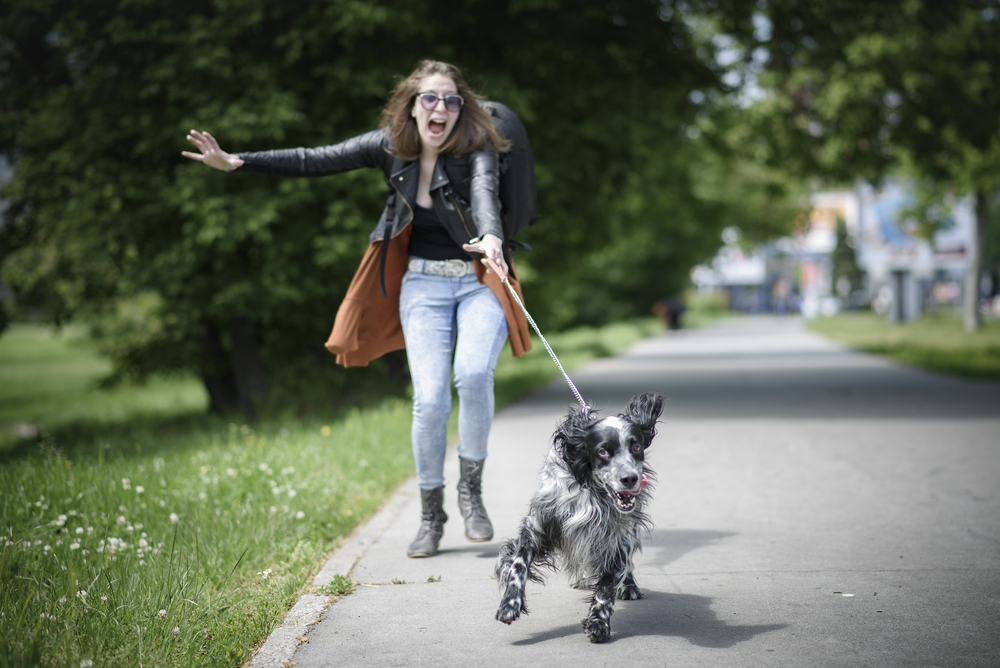Some dogs seem the perfect companions from the day you bring them home, never chewing on a shoe, barking at the mailman, or stealing food off the counter. Other dogs are kicked out of doggy obedience classes, destroy everything in your home, and remind you of Marley the Labrador in the book Marley and Me. While behavior and obedience training can go a long way toward helping your pooch develop polished manners, some behavior issues are medical in nature and require veterinary treatment. Let’s take a look at some of the most common dog behavior problems, their causes, and how to solve them.
#1: My dog barks at everything
Barking is a dog’s main form of communication with their owners, but excessive barking, which can be caused by overstimulation, boredom, or anxiety, can be a nuisance. Depending on the cause, there are multiple ways to help reduce your dog’s barking. Ignore your dog when they begin to bark for no apparent reason, especially if they are seeking your attention at the same time, because any attention, positive or negative, will be seen as a reward for the barking behavior. Also, provide plenty of mental and physical exercise for your pet to ensure they’re not barking out of boredom.
To help curb your pooch’s unwanted barking, teach them the “Quiet” command. First, have them bark on cue by saying “Speak” right before they begin barking. When you can tell they’re nearing the end of their barking session, instruct them to “Quiet” and reward them for stopping.
#2: My dog jumps on all my guests
While a small dog who jumps up to greet you is usually not a problem, a large dog who jumps up to greet your elderly relative can be downright dangerous. Unfortunately, this problem behavior is typically rewarded by pushing the dog down or away, because you are still giving them what they want—your attention.
Teach your dog not to jump in small steps. Give them a quick second of attention the moment all four paws are on the ground, then as they calm down, ask them to sit. Once your dog is sitting—and remains sitting—lavish them with attention and praise. If your dog gets back up and begins dancing around again, wait until they’re calm before petting them.
#3: My dog is mouthy when we play
A puppy who is playing can hurt if they bite with their needle-sharp teeth. They quickly learn that biting is not appropriate when they are scolded by their mother or littermates, and most puppies outgrow this mouthy behavior. However, some dogs carry the behavior through adolescence into adulthood.
When your dog becomes too mouthy while playing and tries to gnaw on your hands and arms, discontinue play immediately. If they jump up and try to bite you, walk out of the room and out of their sight, removing all rewarding behavior. Do not try to push your dog away, because they’ll think it’s a game. To help prevent mouthy behavior further, choose different play styles. Avoid wrestling and tug-of-war if your pet becomes too excited, and stick with hands-off activities, like fetch.
#4: My dog constantly pulls on the leash while walking

Leash-pulling is a common problem behavior, and can be extremely troublesome if your dog lunges at another dog or person. Many dogs become frustrated and reactive when on-leash and prevented from reaching the object of their interest. And, many dogs pull on their leash because their owner simply does not move as quickly.
To help with your dog’s leash-pulling behavior, first teach your pooch how to focus on you. Teach a command, such as “Watch me,” that rewards your dog for making eye contact with you. Advance this skill by heading outdoors where there are plenty of distractions, and see how well your pooch can focus. With enough patience and training, your dog will sit and focus on you as a strange dog or person walks past. For further control when walking your dog, switch from a flat collar to a head collar, like the Gentle Leader. This collar works like a halter on a horse by directing your pet’s head, and thereby their body, where to go. If your dog insists on pulling on the leash, switch things up and immediately start walking in the opposite direction. Your pup will soon learn pulling only makes them go backward.
Beginning their training at an early age is essential for all dogs, as puppy classes and basic obedience courses can help turn your unruly pup into a well-mannered family dog. However, some dogs need additional help to manage behavior issues such as separation anxiety, resource guarding, reactivity, and aggression. In these cases, we may refer you to a veterinary behaviorist for advanced management. On the other hand, medical conditions, such as osteoarthritis, urinary tract infections, cognitive dysfunction, and other health issues can cause major personality changes, and our veterinary team can help your pet in these cases.
If your furry pal isn’t acting normally, or you need help managing their behavior problems, contact our Star of Texas Veterinary Hospital team for an appointment.






